Built on the foundations of the ancient temple of the Roman goddess Juno, the church known as Santa Maria in Aracoeli (St. Mary of the Altar of Heaven) is one of the oldest basilicas in Rome.
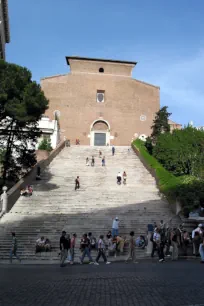
Building the Church on the Hill
Situated at the highest point of the Capitoline Hill, Santa Maria in Aracoeli has a long history. The foundation of a first house of worship may have been laid here as early as the sixth century, when it was built in the style of an ancient basilica. At that time, the worshipers would have followed the Greek rite.
However, the building was taken over by the papacy in the tenth century and was given to the Benedictines. In 1249 Pope Innocent IV passed it on to the Franciscans who remodeled and expanded the church in 1320.
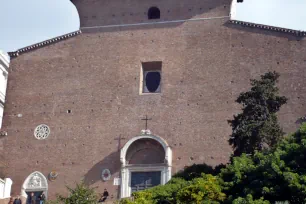
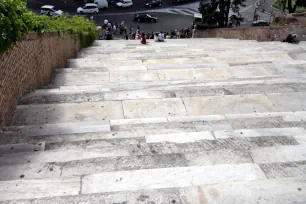
Due to its location near the Palazzo Senatorio – the former seat of the Senate, Santa Maria in Aracoeli became the designated church of the Roman Senate.
In the Middle Ages the city council regularly used the church as an assembly hall and Cola di Rienzo, a politician, addressed the people of Rome from the church’s entrance.
Altar of Heaven
The church was originally known as the Santa Maria in Capitolio. The name Aracoeli is first mentioned in the fourteenth century and comes from a medieval legend. According to this legend, a Sibyl appeared to Emperor Augustus in a vision, foretelling him the arrival of Christ. The emperor then decided to build an altar atop the Capitoline Hill with the inscription ‘Ecce Ara Primogeniti Dei’ (Here is the altar of the firstborn god). Hence the name Ara Coeli, Latin for ‘Altar of Heaven’.
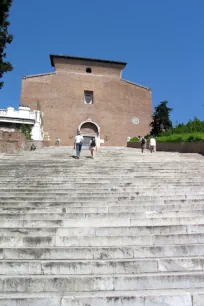

Stairway to Heaven
The large stairway that leads up the hill to the church’s main entrance dates from 1348. Cola di Rienzo ordered the construction of the stairs to thank the Virgin Mary for the end of a large plague epidemic that had ravaged the city that year. The set of 124 marble steps (122 if you start on the right side) was built by Simeone Andreozzi. It is thought that the steps were taken from the Quirinal Hill, where they led to Emperor Aurelian’s Temple of Sol Invictus (Temple of the Unconquered Sun). It was the only major public work undertaken in Rome during the exile of the popes in Avignon (1309-1377). The staircase is often called ‘Stairway to heaven’ since it leads to the Altar of Heaven.
The first person to ascend the stairs was Cola di Rienzo, a colorful leader of Rome who would later be given the title of tribune. An angry mob, unhappy with his rule, tore him to pieces in 1354. In 1877 a statue was erected in his honor. The statue stands between the stairs of the Aracoeli and the Cordonata, a staircase that leads up to the Piazza del Campidoglio.
In the Middle Ages, people believed that if you ascend the stairs on your knees, your sins will be pardoned. Women who wanted a child or were looking for a husband also climbed the stairs on their knees.
The Church
The Facade
The austere looking front facade, with its exposed brick, was built in the fourteenth century. Plans to decorate the facade with mosaics were never realized.
The Interior
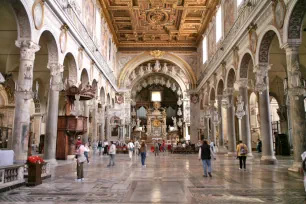
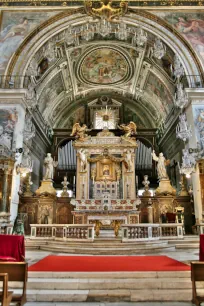

The interior however is much more interesting. It contains three naves, divided by twenty-two Roman columns that are all a bit different from one another, since they were taken from several Roman buildings. On the third column on the left, you can see the Latin inscription ‘a cubicolo augustorum’ (from the chambers of Emperor August).
The beautiful coffered ceiling, created in the sixteenth century, is decorated with nautical themes. It commemorates the famous Battle of Lepanto in 1571 where allied troops defeated the Ottoman fleet.
Also of note are the frescoes in the chapel of San Bernardino, created in the fifteenth century by Bernardino Pinturicchio. The frescoes profile the life of Saint Bernardine of Siena.
A number of other exquisite artworks are also found inside Santa Maria in Aracoeli, including a Transfiguration painted on wood by Girolamo Siciolante da Sermoneta, a tombstone by Donatello and a tomb designed by Michelangelo. Works by other notable artists like Pietro Cavallini, Benozzo Gozzoli, and Giulio Romano can also be admired here.
The most famous object in the church is the so-called Santo Bambino, a statue of the baby Jesus carved from olive wood from the Garden of Gethsemane during the fifteenth century. People once believed that the statue could heal terminally ill people; it would even have the power to raise people from the dead. Encrusted with jewels, the original was stolen in 1994 and never found. A replacement is now used instead and brought out to the high altar on Christmas Eve.
- Next: Piazza Farnese
- More Sights & Attractions in Rome

